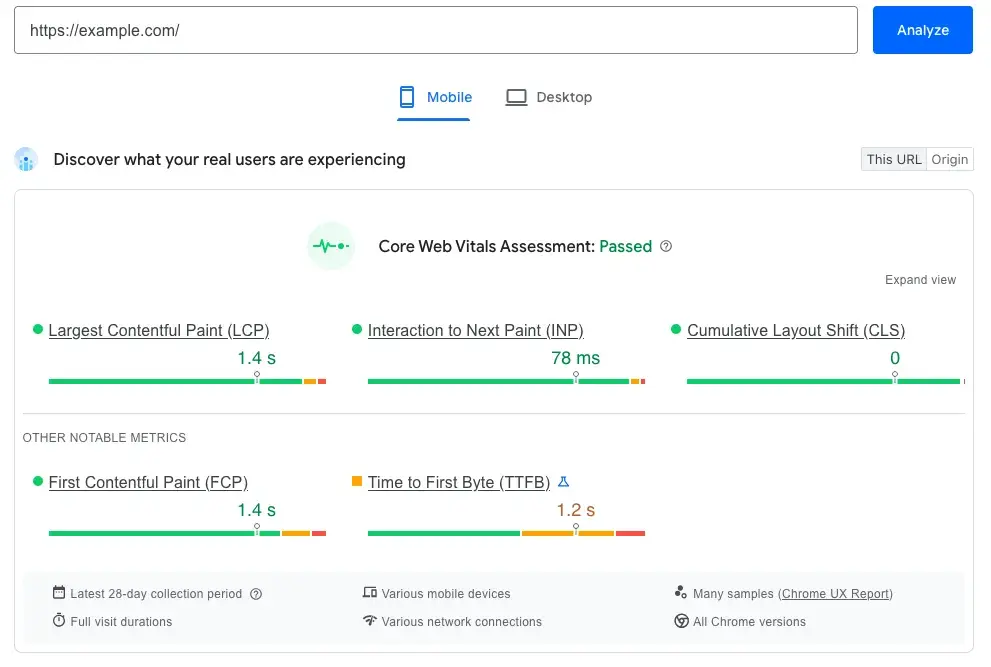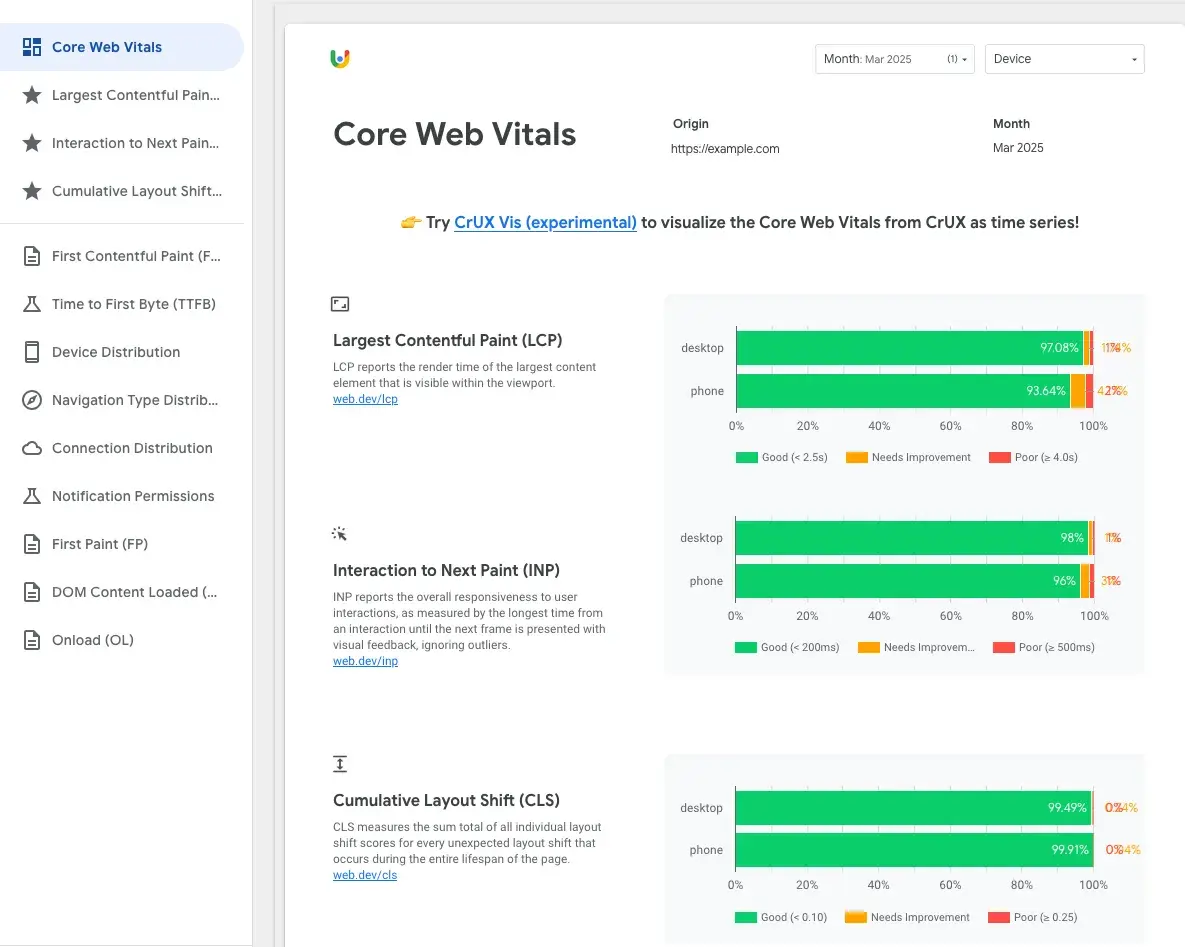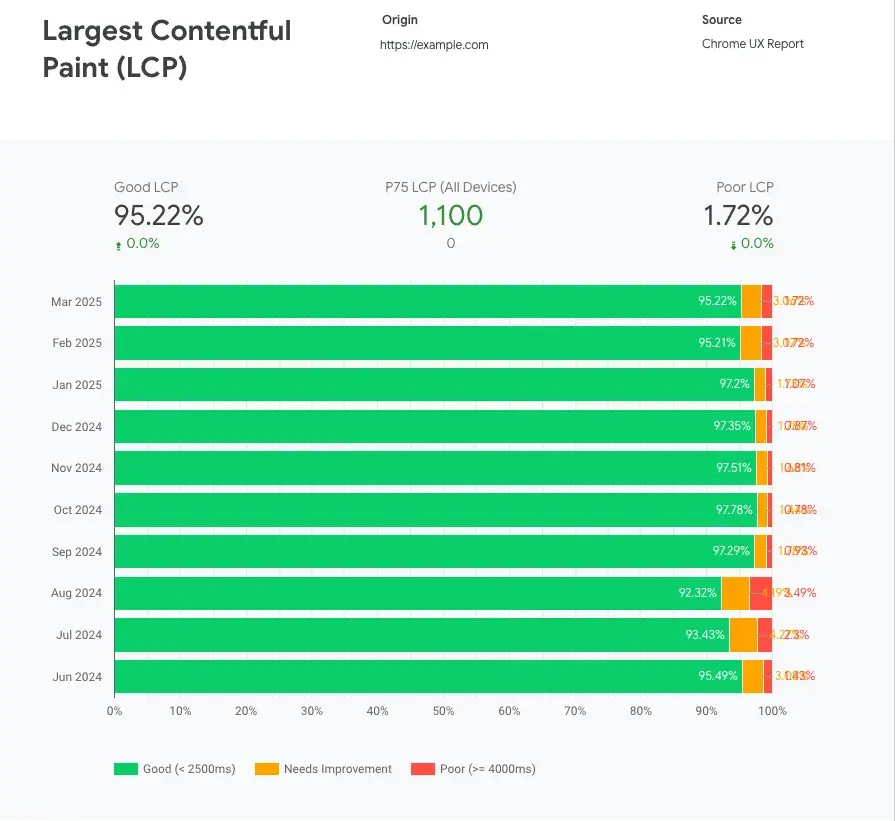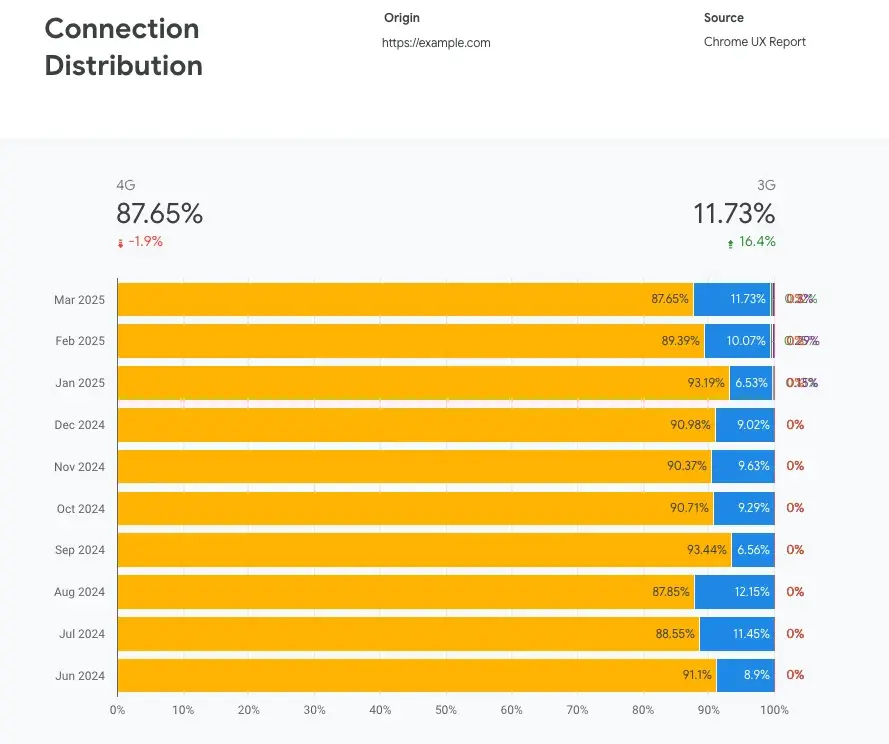This report is an indispensable resource, but I know firsthand that the dataset that powers CrUX reports is massive and can be overwhelming at first glance.
So, in this post, consider me your expert guide as we take a look at the CrUX report together. You’ll learn to better understand the features of the report, what data the CrUX report contains, and begin to explore the dashboard.
Table of Contents
- What is the Chrome UX report?
- What sites are included in the CrUX report?
- How to Access the Chrome UX Report
- A Deep Dive into the CrUX Dashboard
- Start querying CrUX today.
What is the Chrome UX report?
The Chrome User Experience (CrUX) report is a dataset and linked tooling that Google offers as part of its Web Vitals initiative. Google describes the Web Vitals initiative as a way for website owners to understand the quality signals and metrics that Google looks at to determine website quality. Covering over 18 million websites as of 2024, the scope of CrUX is incredible.
How the Chrome UX Report Works
As a browser, Google Chrome accesses countless websites every hour. The CrUX dataset compiles data from Google Chrome browsers as users on desktop and mobile devices access websites around the world.
This collected data is then compiled into the CrUX dataset and presented to website owners to better understand their web performance and quality. CrUX lets you see how your site stacks up against the rest and gives you actionable data you can use when designing and improving your site’s user experience.
As the dataset can be challenging to work with due to its size, most explore the data through the CrUX Dashboard, by querying the dataset directly or through using their provided API.
What the Chrome UX Report Contains
The CrUX report contains critical metrics about website health as well as meta information about how users access the target website.
Key metrics include:
- The time it takes the largest content element on a page to load (Largest Contentful Paint, or LCP).
- A score for your site’s responsiveness to user interactions (Interaction to Next Paint, or INP).
- A score for how responsive your site is to layout changes (Cumulative Layout Shift or CLS).
CrUX also contains meta information about users’ browsing conditions, including device type and connections, which allows you to parse CrUX data by these conditions to better understand your audience segments.
What sites are included in the CrUX report?
While Chrome sees countless websites every day, adding every website on the internet to a queryable dataset like CrUX would be a never-ending task. So, the CrUX dataset only contains a small subset of sites found on the web.
The Chrome UX report includes data from two types of sources: individual webpages and entire websites, which Google calls “origins.”
Pages or origins included in the CrUX must meet two requirements:
- The page or origin must be public. Google should be allowed to index it so that users can find it through Google search.
- The page or origin must be what Google calls “sufficiently popular,” meaning the page/origin must receive a minimum amount of traffic. This ensures a large enough sample size to grade an origin/page.
Google does not share the minimum traffic required for a page or origin to be considered “sufficiently popular.” However, you can easily check whether your web page meets these criteria by plugging the page URL into PageSpeed Insights.
If you see results for your site, it’s publicly discoverable (which, unless you choose to block Google from indexing it, is likely true) and popular enough to be included in the CrUX dataset.
How to Access the Chrome UX Report
CrUX is, at its core, a dataset. And a big one at that. Working with a large dataset like the Chrome UX report can be daunting, but Google offers a range of support for users of all backgrounds.
There are several ways you can view the data and get insights from it. I’ll cover those methods in this section, ranging from least to most technical.
Method 1: Use PageSpeed Insights.
If you’re interested in a quick snapshot of how your website is performing, Google’s PageSpeed Insights tool is the simplest way to access data from CrUX. It’s a free tool that presents the latest performance data for any site in CrUX, segmented by mobile and desktop users.
To use PageSpeed Insights, just paste in the URL of the page you want to analyze. You’ll be given a report of Core Web Vitals for the page, broken down by mobile and desktop performance. You’re able to quickly see core metrics that reflect the experience users have when visiting your website. I like that you can toggle between mobile and desktop to compare the results.

This tool provides scores (and improvement recommendations) from 0 to 100 in four areas:
- Performance (i.e., speed)
- Accessibility
- Best practices
- SEO
If you want quick, actionable feedback on your site or a competitor’s, this tool is a great place to start.
Method 2: Use the CrUX Dashboard in Looker Studio.
The next method of accessing CrUX data is by viewing it through the CrUX Dashboard, a free dashboard in Looker Studio that provides a visualization of CrUX data that you can filter and parse for insights.
If you’re a site owner just beginning to explore data analysis, the CrUX Dashboard is an excellent tool. In my opinion, it’s the best way to view data if you want to achieve more fine-grained insights about your website without knowledge of APIs or SQL.
To use the CrUX Dashboard, enter the URL of origin you want to explore into the text field on this page. Note that it will only accept an origin URL, not a page URL. Next, it will generate a new dashboard for you to use, which can be shared with your team if needed.

This dashboard will show you the familiar Google Core Web Vitals that we saw when we used PageSpeed Insights. Each metric is broken down into the buckets “good,” “needs improvement,” and “poor,” with red/yellow/green color coding. Plus, there are breakdowns by mobile/desktop and connection type to give you more granular information on your site’s performance.
To edit the dashboard, you can make your own copy — just note that the months need to be updated manually (or, create a custom dashboard every month and make a new copy). Also note that the data in the CrUX dashboard updates automatically when new data becomes available.
I’ll dive more into a full CrUX Dashboard demo below, but first, I’ll review two additional ways to view CrUX report data. These are good options for more technical users.
Method 3: Use SQL Queries.
If you’re comfortable using SQL, it’s also possible to use SQL queries to access the CrUX data by querying its database, Google’s BigQuery. This can be a powerful tool for more technical users, but it’s important to note that unlike PageSpeed Insights and the CrUX Dashboard, this method isn’t completely free.
With this method, you can access data as far back as 2017 and achieve more granular insights than what you’d be able to get using PageSpeed Insights or a CrUX Looker dashboard.
In essence, the CrUX Dashboard is just a visualization of the queries it’s making from BigQuery — it’s just doing the work for you so you don’t need to worry about using SQL. But, if you want to access lower-level data for custom reports, this is your best bet.
To query the CrUX dataset with SQL, you’ll need to create a Google Cloud project if you haven’t already. See Google’s guide to getting started with CrUX querying for how to set up a Google Cloud project and tips to start querying with SQL.
As I already mentioned, there are costs associated with accessing the Chrome UX Report data with BigQuery. Luckily, there is a free plan on which you can store up to 10 GiB (a little over 10 gigabytes) and process up to one TiB (a little over one terabyte) per month.
Many users who don’t need to process large amounts of data may be able to get by using the free allowances. There’s also a free trial offer for your first 90 days, which gives you $300 in credit toward queries and storage.
Method 4: Use the CrUX API.
Finally, the CrUX API is a free REST API for accessing the CrUX dataset, but also requires the highest degree of technical skills to use.
The CrUX API aggregates data from the past 28 days to provide its outputs and updates daily. It allows access to data in the report at the page level and origin level. See Google’s documentation for info on how to get an API key and query the APIs.
Google currently provides two APIs for querying the CrUX database:
- CrUX API. Allows access to data within the past 28 days.
- CrUX History API. Allows you to access historical trends in user experience over the past six months, and is updated weekly.
A Deep Dive into the CrUX Dashboard
In this section, I’ll walk through how to analyze a website using the CrUX Dashboard.
I think the CrUX dashboard is the best fit for users who are interested in a highly detailed look at the Chrome UX report dataset.
The dashboard provides a customizable, granular way to get a high-level overview of how your website overall, as well as individual pages, are performing over time. It removes the need to use SQL queries or the CrUX APIs and presents your data in ways that are easy to understand and share.
All CrUX data is public, so you can analyze any website with this method. This means you can check competitors’ websites to better understand their performance, alongside your own sites.
For the purposes of the demonstration, I’ll be using https://example.com/ as the origin URL for the analysis in this section. Example.com is a website maintained for teaching and explaining core web concepts, and a great simple website to use to explore the CrUX Dashboard.
Create a Custom Dashboard
To create my custom dashboard, I’ll start by going to this page and pasting in the URL https://www.example.com.

A CrUX Dashboard is automatically generated for me.
You’ll see a list of tabs on the left side, the first being an overview of Core Web Vitals. On this screen, I can see the performance of different Core Web Vitals from the previous month.

Since I’m viewing this dashboard in March 2025, I can see data as recent as November 2023, going back to 2017. You can toggle the timeframe in the top right corner. But for now, let’s look at December 2024 as an example.
Top Metric: Largest Contentful Paint
The first metric shown is largest contentful paint (LCP). LCP measures the time it takes for the largest text element or image element inside the viewport (i.e., the part of the page visible in the browser) to become visible. It’s a measure of page performance that tells us how long it takes for the main content to display to a user.
By clicking on the LCP tab in the left-hand navigation, we can see this metric by month and broken down by device.

In the graphic provided, I see that, for users on desktop and mobile, the vast majority of users had a “good” experience with LCP (visible in green), which Google defines as less than 2.5 seconds, while “needs improvement” (in orange, between 2.5 and 4 seconds) and “poor” performance (in red, more than 4 seconds) only affected a tiny percentage of users.
If you want to limit the metrics to users on specific devices, you can do so by selecting the desired devices in the device modal in the top right of the LCP view.
Top Metric: Interaction to Next Paint (INP)
The next metric is interaction to next paint (INP), which measures the overall responsiveness to user interactions. It tells us how long the browser takes between a user interaction (like clicking or tapping) and when the browsers start to process event handlers for that action. Basically, when you tell the website to do something, how long does it take to do it?
In the case of example.com, INP is pretty good, with a majority of recent users having a positive experience. Example.com might be an exceptional example of great INP metrics, though, because this is a very simple website that loads quickly between user interactions.

Top Metric: Cumulative Layout Shift (CLS)
Lastly, we have cumulative layout shift (CLS), which measures how much elements shift their positions on the page throughout the lifespan of the page.
Have you ever gone to hit a button, only for the button to move at the last second and cause you to press something else? The lower the CLS score, the less likely this is to happen.

Using example.com for these scores will again show much better CLS than many websites due to its simplicity. To better understand what a good CLS for your websites, I recommend comparing your website to other websites with similar complexity.
Exploring Web Vitals in More Detail
The next three tabs on the sidebar let us explore these three Core Web Vitals in more detail.

Let’s look at the Largest Contentful Paint tab. Here, we see example.com data from the past 10 months. By default, this will include all device types that the Chrome UX report has data for: desktop, mobile, and tablet.

Additionally, the default view for this tab displays data across devices. To filter by desktop or phone, use the dropdown menu in the top right corner.
Next, you can dive deeper into INP and CLS if you want more detail there.
After the three main Core Web Vitals, the CrUX Dashboard lets you view additional metrics which include:
- First Contentful Paint (FCP). The duration from when a page begins to load to when any part of the page from the DOM is visible.
- Time to First Byte (TTFB). The duration between a browser making an HTTP request to the hosting server and the first data of the web page received by the browser in response. Essentially, a measure of latency and server processing speed.
- Device Distribution. Tracks the ratio of mobile to desktop use month over month.
- Navigation Type Distribution. Displays a breakdown of how your users are loading your site, giving you insights into the number of returning visitors
- Connection Distribution. Shows which connections are most used. For example.com, most mobile users are connecting with 4G or 3G.
- Notification Permissions. Whether users accept, dismiss, deny, or ignore notification permissions when prompted by the browser.
- First Paint (FP). The duration from when the page starts to load to when the first pixel is visible onscreen.
- DOM Content Loaded (DCL). The duration from when the page starts to load to when the DOM is fully loaded (not including stylesheets and images) and can be accessed by scripts.
- Onload (OL). The time taken for the page and all dependent resources to load.

Start querying CrUX today.
The great thing about the CrUX is that you have different viewing options.
If the CrUX Dashboard is too in-depth and you just need to get an idea of your site’s performance at a glance, PageSpeed Insights will probably be able to help you more quickly.
Or, if you have the technical skills and need a more detailed understanding of your website’s metrics and/or want to build custom reports, consider using SQL queries or accessing its APIs. There is an option for anyone who wants to understand their website, regardless of technical expertise.
So, if you want to find out the truth about your site’s performance, there’s a dataset with your site’s name on it — ahem, in it.
Editor's note: This post was originally published in February 2024 and has been updated for comprehensiveness.
User Experience
.png?width=112&height=112&name=Image%20Hackathon%20%E2%80%93%20Square%20(10).png)
.png)

![How to become a UX designer, a step-by-step guide [expert tips]](https://53.fs1.hubspotusercontent-na1.net/hubfs/53/become-a-ux-designer-1-20240731-321437.webp)


![How to Add a Parallax Scrolling Effect to Your Website [Examples]](https://53.fs1.hubspotusercontent-na1.net/hubfs/53/scroll-Aug-11-2023-05-24-08-8793-PM.png)

![20 UX Design Examples Hand-Picked by Experts [With Analysis]](https://53.fs1.hubspotusercontent-na1.net/hubfs/53/ux-design-examples-1-20250404-8425368.webp)

